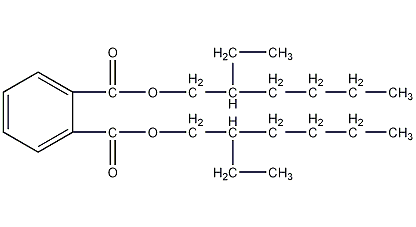
Structural formula
| Business number | 0399 |
|---|---|
| Molecular formula | C24H38O4 |
| Molecular weight | 390.56 |
| label |
1,2-Di(2-ethylhexyl)phthalate, Di(2-ethylhexyl) phthalate, DEHP, Di(2-ethylhexyl) Phthalate, Dioctyl Phthalate, DOP, Phthalic Acid Bis(2-ethylhexyl) Ester, Phthalic Acid Di(2-ethylhexyl) Ester, Phthalic Acid Dioctyl Ester, plasticizer, condensing agent, anti-wear agent, acaricides, Gas Chromatography Stationary Solution |
Numbering system
CAS number:117-81-7
MDL number:MFCD00009493
EINECS number:204-211-0
RTECS number:TI0350000
BRN number:1890696
PubChem number:24862744
Physical property data
1. Properties: colorless or light yellow viscous liquid with slight odor.
2. Relative density (g/mL, 20/4℃): 0.986
3. Relative vapor density (g/mL, air=1): >16
4. Melting point (ºC): -55
5. Boiling point (ºC, normal pressure): 384
6. Boiling point (ºC, 0.6666KPa): 230
7. Refractive index (20ºC): 1.4859
8. Flash point (ºC, opening): 109
9. Autoignition point or ignition temperature (ºC ): 241
10. Vapor pressure (kPa, 200ºC): 0.16
11. Vapor pressure (kPa, 20ºC): <0.0013
12. Explosion Lower limit (%, V/V): 0.3
13. Viscosity (mPa·s, 20ºC): 81
14. Conductivity (S/m, 25ºC): 7.4× 10-13
15. Solubility: Insoluble in water, miscible with general organic solvents. It has strong dissolution of cellulose acetoacetate, cellulose nitrate, polymethyl methacrylate, synthetic rubber, dammar resin, coumarone resin, styrene-vinyl chloride-vinyl acetate copolymer and vinyl chloride. ability. Polyvinyl acetate and shellac are difficult to dissolve.
16. Liquid phase standard hot melt (J·mol-1·K-1): 704.7
Toxicological data
1. Irritation: Rabbit transdermal: 500mg/24 hours, mild irritation. Rabbit eye: 500mg/24 hours, mild irritation.
2. Acute toxicity: ratsAlcohol = 1:2 (mass), the catalyst amount is 0.25% ~ 0.3% (mass) of the total material amount, the activated carbon added during esterification is 0.1% ~ 0.3% (mass) of the total material amount; esterification temperature 150℃, esterification time is about 3h. The hot water temperature for crude ester washing is 80~85℃; the temperature for distillation recovery of octanol is 130~140℃, the residual pressure in the tower is not higher than 93.31kPa; the flash point of crude ester must be above 190℃. To produce high-grade products, the crude ester after dealcoholization needs to be distilled and then filtered. The esterification reaction formula is as follows:

Purpose
1. Used as plasticizer, condensing agent, antifriction agent and gas chromatography fixative for polyvinyl chloride resin.
2. This product is the most widely used plasticizer in plastic processing. In addition to cellulose acetate and polyvinyl acetate, it has good compatibility with most synthetic resins and rubbers used in industry. Capacity. This product has good comprehensive properties, including good mixing performance, high plasticizing efficiency, low volatility, water extraction resistance, high electrical properties, good heat resistance and weather resistance. As a main plasticizer, this product is widely used in the processing of various soft products of polyvinyl chloride. It can be used in nitrocellulose paint to make the paint film elastic and have high tensile strength. It can also be used for packaging materials in contact with food, but because it is easily extracted by fat, it is not suitable for packaging materials for fatty foods. This product can also be used as a softener for synthetic rubber, which can improve the resilience of products and reduce compression permanent deformation without affecting the vulcanization of the rubber.
3. Used as a plasticizer for epoxy resin, nitrile adhesive, PVC plastisol and sealant. It is the most widely used general-purpose plasticizer at present. It has good comprehensive properties, high plasticizing efficiency, low volatility, good low-temperature softness, low water extraction resistance and migration, good UV resistance, heat resistance and weather resistance. , widely used in the processing of polyvinyl chloride, vinyl chloride copolymers, and cellulose resins to manufacture soft films, sheets, artificial leather, wires and cables, wallpapers, molded products, plastic shoes, etc., and also used in the manufacture of food packaging materials, medical Blood bags etc. It is also the industrial standard for general-purpose plasticizers for polyvinyl chloride and is used as a standard for comparison with other plasticizers. It is also used as a plasticizer for epoxy resin, nitrile adhesive and PVC plastisol sealant.


